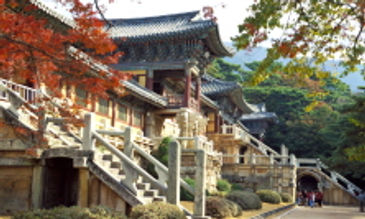
UNESCO World Heritage of Korea
Since the earliest settlements on the Korean Peninsula and in southeastern Manchuria during prehistoric times, the people of Korea have developed a distinctive culture based on their unique artistic sensibility. The geographical conditions of the peninsula provided Koreans with opportunities to receive both continental and maritime cultures and ample resources, which in turn enabled them to form unique cultures of interest to and value for the rest of humanity, both then and now.

Seokguram:
World of Eternity beyond the Human Realm
Overlooking the East Sea beyond mountain ridges from the southeastern tip of the Korean peninsula, Seokguram lies 565 meters above sea level near the summit of Mt. Toham. The cave chapel was originally built as a hermitage affiliated with a temple named Seokbulsa in accordance with the wishes of Kim Dae-seong, a state councilor during the reign of King Gyeongdeok of Silla. Its construction began in 751 and was completed in 774 under the reign of King Hyegong. The temple became dilapidated due to poor management in modern times but the hermitage has survived with its sublime beauty and profound religious symbolism.
Bulguksa Temple in Gyeongju

Bulguksa:
Architectural Realization of the Buddha Land
While Seokguram’s sculptural works expressed the unfathomable meaning in the Buddha’s awakening, Bulguksa aimed to create an architectural realization of the Buddha’s teachings in the present world. The construction of the temple also began in 751, half way up the west side of Mt. Toham in accordance with the wishes of Kim Dae-seong, and was completed in 774. The grotto shrine was to honor Kim’s parents in his previous life, and the temple was for his parents in the present life.

Haeinsa Temple Janggyeong Panjeon, the Depositories of the Tripitaka Koreana Woodblocks
In recognition of its outstanding universal value as a legacy of medieval printing technology as well as unrivaled canonical content, the Tripitaka Koreana was placed on the UNESCO World Heritage List in 2007. The inscription of the depository halls came much earlier in 1995, a tribute to the prominent wisdom of ancient Korean architects and engineers that defies explanation by modern science.



